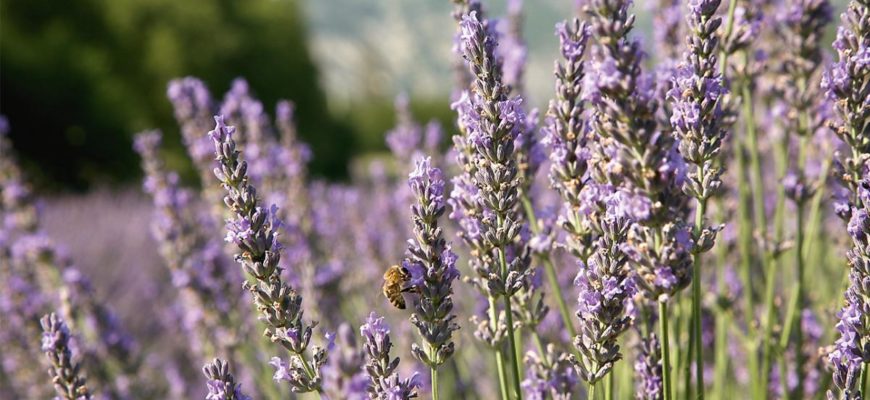
Find out more about the True lavender plant of our Aromatherapy Herbarium blog series.

TRUE LAVENDER
Common lavender
Lavandula angustifolia
DESCRIPTION

We cannot mention the name of true lavender (Lavandula angustifola ssp. angustifola (syn. lavendula vera, L. officinalis), without thinking about immense exquisitely blue fields.
ADVICE
Essential oil of true lavender may be used in small children as long as it is diluted.
DO NOT USE IN
– pregnant or breast-feeding women,
– children under the age of three years (always dilute),
– persons allergic to one of the components (geraniol, linalool, limonene),
– subjects with asthma without the advice of an allergologist before the first use.
RECIPES
Burns, sunburns, irritated skin
Apply 2 or 4 drops of pure essential oil of lavender or diluted to 50% in aloe vera gel to apply on the irritated or infected zone.
Nervous disorders
Use 2 drops of essential oil of true lavender to massage the solar plexus.
Breath in 1 ml of lavender placed on a diffuser during the day to calm you or in the evening to sleep better.
Pour 10 drops of essential oil of lavender in a spoonful of powdered milk or neutral base for the bath in very hot water. Relax for about twenty minutes, dry yourself without rinsing and go to bed.

Rare are the words that have such an evocative power as this shrub of fifty to seventy centimetres of the Lamiaceae family, which loves air, space, light and heat.
Celebrated since antiquity, lavender was one of the numerous “nards” (fragrant herbs) of the Greeks. It was used to clean and perfume the thermal baths, an institution that was appreciated in the Roman world but which was easily foul smelling. The term “lavender” appears in the Middle Ages, derived from the Latin verb lavare (wash). Its use was associated with fighting diseases because for a long time it was thought that bad smells propagated diseases. It was one of the simples cultivated in monastery gardens. Its use in perfumery mainly started in the 19th century. True lavender is one of the major aromatherapy plants: it does not just have a pleasant fragrance, it also provides an extremely multivalent and effective essential oil. Today, while maintaining the summer harvest of former years on difficult fields between a thousand and fifteen hundred metres in altitude, we cultivate hybrid species: the harvest is still carried out using a sickle after the morning dew.
CULTIVATION AND PRODUCTION
There are about four thousand hectares of first grade lavender cultivated in the four producer departments in the South of France. However, hybrid lavenders occupy much greater surfaces. Out of its initial natural area in the Mediterranean basin, lavender has also been cultivated since a few years in Bulgaria, Ukraine and even Canada. Grasse, the capital of the perfume industry, is the cradle of lavender, as this industry consumes great quantities. However, only the essential oil from the production of true lavender on a specific zone benefits from the controlled origin label (AOC). (See page 105).
FRAGRANCE
This pale yellow essential oil exudes a delicate fragrance which faithful to its etymology “lavare” evokes a “clean smell”. From the earliest times it could only have a great success, especially in cosmetics, where it is the base of numerous perfumes, including the famous “Jicky” by Guerlain (1889).
EXTRACTION AND YIELD
Essential oil of true lavender is extracted from the flowering tops of the plant by steam distillation. This must take the time required for the “passage”, i.e. sixty to a hundred minutes. No less than a hundred kilograms of true lavender flowers are required to obtain five hundred to eight hundred millilitres of essential oil, i.e. a yield of 0.5% to 0.8%.
CHEMICAL FORMULA
The main chemical components of this precious essential oil are linalyl acetate and linalool.
MAIN INDICATIONS
Lavender can treat insomnia, irritability, anxiety attacks and various manifestations due to stress. It is also used as a muscle relaxant. Furthermore, it is an ally against skin problems in particular acne, eczema and psoriasis. An antiseptic that prevents infections, and an anti-parasite that also repels lice.


Leave a Comment